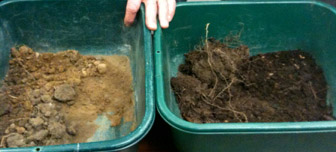By Catherine Wachs
It’s practically a ritual in Westchester. Spread fertilizer on the lawn in the spring and fall, maybe even twice more during the summer, so it stays a bright green. Add limestone to keep the soil alkaline, to increase nutrient uptake. Apply a pre-emergent to control the weeds. Spray Roundup and pesticides when needed.
This ritual took hold in the late 1950’s. Up until then, lawns weren’t that big a deal. People just mowed and either put up with weeds or hand pulled them. Quite a few people were growing food in their “victory gardens” wherever there was space and sun.
Just after World War II, when all the G.I.’s were buying homes, the lawn became the mandated symbol of community pride. Not so coincidentally, the factories producing nitrogen for bombs needed another way to make profits. Enter chemical lawn fertilizers.
Bags of these fertilizers combine nitrogen, phosphorous and potassium, the main minerals needed for plant growth. (The 3 numbers you typically see on fertilizer bags, e.g. 5-3-5, represent N-P-K: nitrogen-phosphorous-potassium.) These minerals are usually present in sufficient amounts in your soil. The commercial fertilizers give your lawn a super dose of growth promoters. So super that your lawn will look thick, lush and bright green in a matter of days. But this creates problems.
Problem #1: Nitrogen Addiction
Your grass cannot possibly absorb the sudden, large amounts of nitrogen. Insects, which are also looking for nitrogen as a food source, are attracted to the excess. So now you have an insect problem, like whiteflies. What does the gardener do? Spray insecticide. Which kills the bad bugs, but also all the good bugs. These good bugs are the predators that would eat the bad bugs. They don’t bounce back as fast as the pests, for the same reason why there are a lot more rats than hawks. Nature tries to keep a balance of food sources. The very thing fertilizers and herbicides mess with.
Problem #2: Grass on Steroids
These chemical fertilizers make the lawn look intensely green because they cause quick growth. So quickly, that the growth cannot be supported indefinitely. The blades die, clogging the lawn, creating a condition called thatch. Too much thatch traps humidity in the lawn, creating conditions for mold and mildew to move in.
Problem #3: A Disrupted Ecosystem
Nitrogen, phosphorous and potassium are important minerals. Just as important are the millions of creatures and microbes that contribute to healthy soil. Soil may look like dirt, but it contains an entire ecosystem of fungi, bacteria, predators and prey. Many have specific jobs, such as bacteria that help plant roots absorb the minerals, fungi that recycle wood and worms that aerate the soil and recycle organic matter. Lime, a common lawn care additive, is toxic to to worms.
Kicking the Habit
Soil on the right has a high organic content, evidenced by its dark color.
But, you say, “I want a beautiful green lawn.” You can still have a lush lawn without chemicals. The main objective is to build healthy soil. The grass will take care of itself.
Soil on the right has a high organic content, evidenced by its dark color.
Soil on the right has a high organic content, evidenced by its dark color. If you are transitioning from chemicals, use an organic, slow release fertilizer. Apply it only once, in the Fall. After that, the idea is feed the soil organisms by adding organic matter or humus (leaves, dead plants). As you supply more food, the ecosystem will flourish. Your soil will eventually attain a black-brown color, evidence of good humus content.
1. Once or twice a year, top dress your lawn with compost (make sure it’s a reputable, organic source, not containing milorganite, otherwise known as sewage sludge). Simply spread a thin layer over your lawn by raking or by using a spreader. This will add soil critters to the earth under the lawn.
2. Leave the grass clippings on the lawn. They are not large and will disappear quickly into your lawn supplying even more food. Your gardener can just unclip the grass catcher.
3. Mow 4” or at highest setting, Taller blades make stronger roots. They also shade out weed seeds better.
4. Mow less in the heat of summer, when the grass is dormant and barely growing. Even grass gets stressed out in hot weather.
5. Twice a year, when the forsythia bloom and again around Labor Day, apply corn gluten to discourage weed seeds from germinating. You must let new grass grow before applying corn gluten or sow grass 6 weeks after application, since the corn prevents germination. This is not like a chemical and it will take several seasons, plus some hand pulling (I pay a kid a penny a weed), to keep dandelions out of the turf.
6. Mow right over any leaves on your lawn in the fall. The little pieces will fall between the blades, adding more food. Rake or blow extra leaves into your garden beds, under and around the shrubs. (You will have gorgeous, black soil in the beds in a year’s time.) If you don’t like the natural, “forest floor” look in your beds, you can cover them with shredded mulch. The more organic matter the better.
7. Plant roots need air. High traffic areas can be lifted slightly with a pitchfork, so as not to rip up the grass but just “fluff” the soil 3” underneath. Consider step stones or a mulch path.
8. Give up trying to grow grass under a shady tree, especially if there is moisture. It will never grow well. Weak, diseased grass is a symptom of an unhappy plant. Listen to the symptoms. Grow a groundcover, which can be stunning, and very low maintenance. Pachysandra is more well-behaved than ivy or wintergreen.
Be Patient.
Lawn rehab, just like the human variety, is ugly in the beginning, as your lawn’s ecosystem detoxes. It may take 2 seasons. But when you kick the chemical habit, you’ll find you’ll be spending less time, water and money on your lawn, with better results, and a healthier environment for your kids and pets.
One note about watering. Setting the automatic sprinkler for watering 20 minutes in each zone adversely encourages shallow root growth. Plus, the water evaporates quickly in the heat. It is much better to water an hour per zone a week, about 1 inch of water, very early in the day. This encourages grass roots to go deeper to find the water. Most established shrubs need no extra water and may even be harmed by getting too much.
The hardest part of all this is educating your lawn care service. They only know one way and it may take several seasons for them to comply. Some will never get it, they only know how to charge for chemical applications, so you may have to find a new service.



